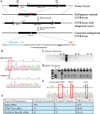Functional Gene Correction for Cystic Fibrosis in Lung Epithelial Cells Generated from Patient iPSCs - PubMed (original) (raw)
Functional Gene Correction for Cystic Fibrosis in Lung Epithelial Cells Generated from Patient iPSCs
Amy L Firth et al. Cell Rep. 2015.
Abstract
Lung disease is a major cause of death in the United States, with current therapeutic approaches serving only to manage symptoms. The most common chronic and life-threatening genetic disease of the lung is cystic fibrosis (CF) caused by mutations in the cystic fibrosis transmembrane regulator (CFTR). We have generated induced pluripotent stem cells (iPSCs) from CF patients carrying a homozygous deletion of F508 in the CFTR gene, which results in defective processing of CFTR to the cell membrane. This mutation was precisely corrected using CRISPR to target corrective sequences to the endogenous CFTR genomic locus, in combination with a completely excisable selection system, which significantly improved the efficiency of this correction. The corrected iPSCs were subsequently differentiated to mature airway epithelial cells where recovery of normal CFTR expression and function was demonstrated. This isogenic iPSC-based model system for CF could be adapted for the development of new therapeutic approaches.
Copyright © 2015 The Authors. Published by Elsevier Inc. All rights reserved.
Figures
Figure 1. Footprint-free CRISPR-mediated correction of CF iPSC
A) Schematic of strategy used for CRISPR-mediated correction of the CFTR ΔF508 mutation. Red triangle denotes the ΔF508 deletion (shown in red in the sequence at the bottom) and green triangles the correction of the deleted triplet of bases. The TTAA pBac recognition site is underlined. The actual CFTR target sequence is shown below with the gRNA target sequence in blue and the PAM in green. B) Sequencing analysis of the endogenous CFTR gene at the genomic locus of the ΔF508 mutation from wild type and CF patient-derived iPSC. The position of the CTT deletion in the mutant iPSC as compared to the wild type is indicated by the red box and arrow. C) Integration-specific PCR of puromycin resistant single-cell clones of CF iPSC after CRISPR treatment. Indicated clones contain the integrated selection cassette and corrective sequence in the correct position at the CFTR genomic locus. D) Screening by ClaI digest of a single-cell corrected clone after excision and negative selection of unexcised clones by ganciclovir. Indicated clones show precise and complete excision of the selection cassette from the endogenous CFTR genomic locus leaving behind only the corrected F508 sequence and the intended silent mutations encoding the restrictions sites used for screening here. E) Sequence analysis of corrected, excised clone showing the corrected ΔF508 mutation and adjacent silent mutations introduced in the endogenous CFTR gene. F) Table of excision screening done with different variations of the pBac transposase.
Figure 2. Generation of Functional Respiratory Epithelial Cells from CF mutant and gene corrected iPSC
A) Representative images of CF corrected and CF mutant iPSC differentiation to DE (Day 5); DAPI (Blue) and FOXA2 (Cyan), Scale bar white =100µm, yellow =20µm. B) mRNA expression of DE, AFE and lung epithelial cells markers over the time course of differentiation for wildtype, CF mutant and CF corrected iPSC; data are corrected for internal controls and normalized to wildtype iPSC cDNA (mean ±SEM, n=6–15 from a minimum of 3 experimental replicates). C) Averaged current/voltage plots for baseline (blue), in presence of Forskolin, genistein and isobutylmethyl xanthine (IBMX) (pink) and with the addition of CFTRinh-172 (green).Data represented are mean ±SEM for 0 of 4 patched mutant cells and 3 of 8 patched gene corrected cells. Lower panels are representative current traces from one gene corrected differentiated epithelial cell at baseline, and in the presence of FSK cocktail and CFTRinh-172 (L to R), traces represent 20mV increments from −80 to +80mV. D) Western blot showing the presence of the membrane translocated and glycosylated protein in the wildtype and gene corrected cells (Band B) and the unglycoslylated CFTR band in all 3 cell lines (Band A). WT= wildtype, M = mutant, C= gene corrected.
References
- Boyd AC, Porteous DJ. Revisiting the mouse lung model for CF. Gene Ther. 2004;11:737–738. - PubMed
- Cho SW, Kim S, Kim JM, Kim JS. Targeted genome engineering in human cells with the Cas9 RNA-guided endonuclease. Nat Biotechnol. 2013;31:230–232. - PubMed
Publication types
MeSH terms
Substances
Grants and funding
- R01 AI048034/AI/NIAID NIH HHS/United States
- P30 CA014195-38/CA/NCI NIH HHS/United States
- R37 AI048034/AI/NIAID NIH HHS/United States
- P30 CA014195-40/CA/NCI NIH HHS/United States
- T32 GM007240/GM/NIGMS NIH HHS/United States
- P30 NS072031-03/NS/NINDS NIH HHS/United States
- AI048034/AI/NIAID NIH HHS/United States
- HL053670/HL/NHLBI NIH HHS/United States
- R01 HL053670/HL/NHLBI NIH HHS/United States
- P30 NS072031/NS/NINDS NIH HHS/United States
- P30 CA014195/CA/NCI NIH HHS/United States
LinkOut - more resources
Full Text Sources
Other Literature Sources
Medical

